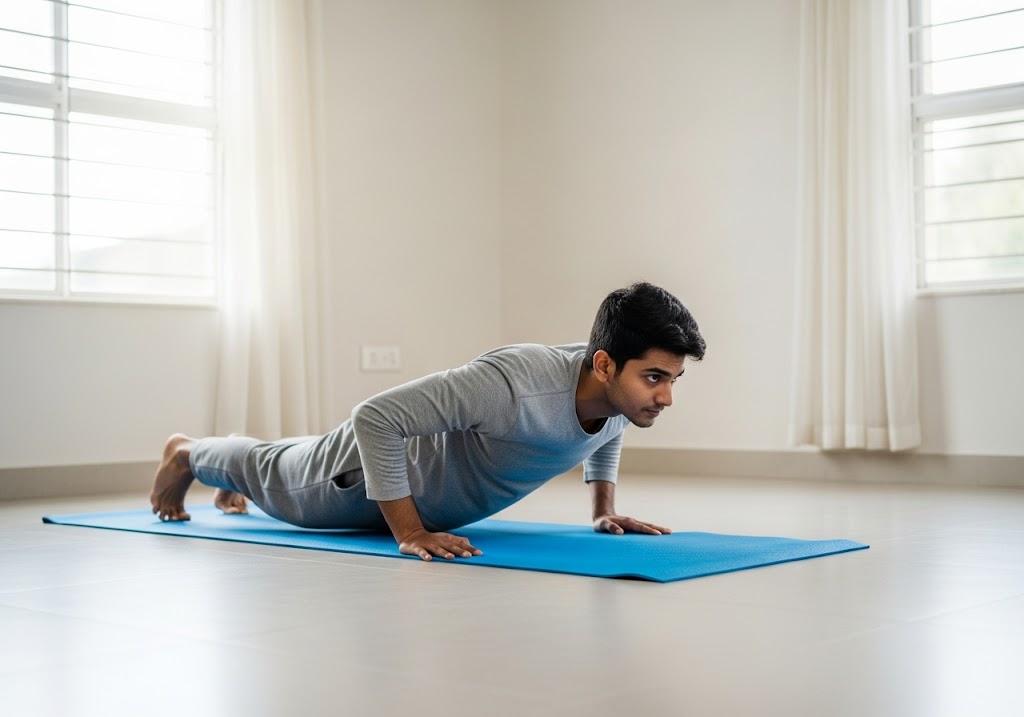500 Skipping Burns How Many Calories? 500 skipping burns approximately 25-50 calories depending on your body weight, with lighter individuals (50-60kg) burning around 25-30 calories and heavier individuals (80kg+) burning 40-50 calories.
Want to know exactly how many calories does 500 skips burn for effective weight loss planning? The answer depends on several factors including your body weight, skipping intensity, and technique, but generally ranges from 25-50 calories for most people. Understanding these variables helps optimize your workout routine and set realistic expectations for your fitness goals.
Skipping rope is one of the most efficient cardio exercises for burning calories and improving cardiovascular health. When you’re wondering about 500 skipping burns how many calorie, you’re looking at a time-efficient exercise that can significantly contribute to your daily calorie deficit and weight loss journey when performed consistently.
Table of Contents
500 Skipping Burns How Many Calories? – Quick Answer
The direct answer to 500 skipping burns how many calories varies based on individual factors, but provides a reliable estimate for planning your workout routine. Most people burn between 25-50 calories when performing 500 skips, making it an excellent addition to any weight loss program. The calorie burn from jumping rope depends on several factors including body weight, exercise intensity, and individual metabolism. A moderate-intensity skipping session can burn 200-300 calories in just 20 minutes, making it incredibly time-efficient compared to other cardio exercises. This efficiency makes skipping an excellent choice for busy individuals seeking maximum results.
| Body Weight (kg) | Calories/Minute | 500 Skips (approx) | 1000 Skips (approx) |
|---|---|---|---|
| 50 | 8-10 | 20-25 | 40-50 |
| 60 | 10-12 | 25-30 | 50-60 |
| 70 | 12-14 | 30-35 | 60-70 |
| 80 | 14-16 | 35-40 | 70-80 |
| 90 | 16-18 | 40-45 | 80-90 |
Your body weight significantly impacts how many calories are burned by skipping 500 times, with heavier individuals burning more calories due to increased energy expenditure. A 60kg person typically burns around 25-30 calories, while an 80kg person may burn 35-45 calories during the same 500 skips. The intensity and speed of your skipping also affect the total calorie burn.
For comprehensive bodyweight training that complements skipping, exploring bodyweight exercises for beginners provides excellent foundation movements for complete fitness development.

How Does Your Weight Impact the Number of Calories Burned in Jumping Rope?
Body weight directly correlates with calorie expenditure during skipping, as heavier individuals require more energy to move their body mass. This relationship helps explain why 500 times skipping burns how many calories varies significantly between different people performing the same exercise routine. The physics behind this concept is straightforward: larger bodies require more energy to perform the same movements due to increased mass displacement. A person weighing 90kg will burn approximately 60-80% more calories than someone weighing 50kg during identical skipping sessions. This doesn’t mean heavier individuals have an advantage, but rather that calorie calculations must account for individual body composition.
Weight Categories Impact on Calories Burn
Lightweight individuals (50-60kg) typically burn fewer total calories but may achieve better cardiovascular benefits relative to their body size. Medium-weight individuals (60-80kg) fall into the average calorie burn ranges most commonly cited in fitness literature. Heavyweight individuals (80kg+) burn the most total calories but may find the exercise more challenging initially.
Metabolic Factors Beyond Weight
Individual metabolism, muscle mass percentage, and fitness level also influence how many calories does 500 skips burn beyond simple weight calculations. People with higher muscle mass burn more calories at rest and during exercise, while improved fitness levels may actually reduce calorie burn efficiency as the body becomes more adapted to the movement.
For additional cardio exercises that complement skipping, jumping jacks exercise benefits provides excellent alternatives for complete cardiovascular training.
How Many Calories Do You Burn Every 100, 200, 500, or 1000 Skips?
Understanding calorie burn across different skip counts helps plan effective workout routines and track progress accurately. These calculations provide practical guidance for anyone wondering about 500 skipping a day burns how many calories for their fitness goals.
| Skip Count | Light (50-60kg) | Medium (60-80kg) | Heavy (80kg+) |
|---|---|---|---|
| 100 skips | 5-8 calories | 8-12 calories | 12-15 calories |
| 200 skips | 10-15 calories | 15-20 calories | 20-25 calories |
| 500 skips | 20-30 calories | 30-40 calories | 40-50 calories |
| 1000 skips | 40-60 calories | 60-80 calories | 80-100 calories |
These estimates assume moderate intensity and average skipping speed of approximately 120 skips per minute. Faster speeds or higher intensity intervals can increase these numbers by 20-30%, while slower, more relaxed skipping may reduce calorie burn slightly.
Curious how many calories your stronger lifts will torch? Find out in our article on deadlift calories burned
How Many Calories Does Every 100 Skips Burns?
One hundred skips represents a quick burst of cardiovascular activity, typically taking 45-60 seconds to complete at moderate pace. This short interval provides an excellent warm-up or active recovery period while burning a modest but meaningful number of calories. Perfect for beginners building endurance or breaking longer sessions into manageable chunks.
100 Skips Breakdown
- Duration: 45-60 seconds
- Light Weight (50-60kg): 5-8 calories
- Medium Weight (60-80kg): 8-12 calories
- Heavy Weight (80kg+): 12-15 calories
- Intensity Level: Low to Moderate
- Best For: Warm-up, active recovery, beginner sessions
How Many Calories Does Burn Every 200 Skips Burns?
Two hundred skips creates a solid mini-workout lasting approximately 90-120 seconds, elevating heart rate significantly while building cardiovascular endurance. This count serves as an excellent stepping stone for intermediate practitioners or as multiple sets throughout the day. The calorie burn doubles from 100 skips, providing meaningful metabolic benefit for time invested.
200 Skips Breakdown
- Duration: 90-120 seconds
- Light Weight (50-60kg): 10-15 calories
- Medium Weight (60-80kg): 15-20 calories
- Heavy Weight (80kg+): 20-25 calories
- Intensity Level: Moderate
- Best For: Quick energy burst, interval training, daily habit building
Want to lift heavier while burning more? Check out our guide on how to increase your deadlift strength
How Many Calories Does Burn Every 500 Skips Burns?
Five hundred skips represents a substantial cardiovascular workout requiring 4-6 minutes to complete, providing significant calorie burn and fitness benefits. This count challenges cardiovascular endurance while building lower leg strength and coordination skills. Many fitness enthusiasts use 500 skips as a daily goal for maintaining cardiovascular health and weight management.
500 Skips Breakdown
- Duration: 4-6 minutes
- Light Weight (50-60kg): 20-30 calories
- Medium Weight (60-80kg): 30-40 calories
- Heavy Weight (80kg+): 40-50 calories
- Intensity Level: Moderate to High
- Best For: Daily fitness goal, cardio workout, endurance building
How Many Calories Does Burn Every 1000 Skips Burns?
One thousand skips constitutes a complete cardiovascular training session lasting 8-12 minutes, delivering substantial calorie burn equivalent to many gym cardio machines. This challenging count builds exceptional endurance, coordination, and lower body strength while torching calories efficiently. Advanced practitioners often use 1000 skips as a foundation for comprehensive fitness routines.
1000 Skips Breakdown
- Duration: 8-12 minutes
- Light Weight (50-60kg): 40-60 calories
- Medium Weight (60-80kg): 60-80 calories
- Heavy Weight (80kg+): 80-100 calories
- Intensity Level: High
- Best For: Complete workout, advanced training, maximum calorie burn
For understanding how other exercises compare in calorie burn, how many push ups to burn 100 calories provides excellent context for exercise efficiency comparisons.
How Many More Calories Are Burned from Skipping the Rope Faster?
Increasing skipping speed significantly boosts calorie burn, with faster tempos burning 25-40% more calories than moderate speeds. This intensity factor helps explain variations in how many calories are burned by skipping 500 times across different workout sessions. Fast skipping (150+ skips/minute) elevates heart rate more dramatically and engages additional muscle groups for stability and coordination. This increased physiological demand translates directly to higher energy expenditure and improved cardiovascular benefits. However, maintaining proper form becomes more challenging at higher speeds.
Speed vs. Calories Burn Comparison Table
| Speed Level | Skips per Minute | Light (50-60kg) | Medium (60-80kg) | Heavy (80kg+) | % Increase vs Slow |
|---|---|---|---|---|---|
| Slow/Easy | 80-100 skips | 6-8 cal/min | 8-10 cal/min | 10-12 cal/min | Baseline |
| Moderate | 100-120 skips | 8-10 cal/min | 10-12 cal/min | 12-15 cal/min | 25-33% |
| Fast | 120-140 skips | 10-13 cal/min | 13-16 cal/min | 16-20 cal/min | 50-67% |
| Very Fast | 140-160 skips | 12-15 cal/min | 15-20 cal/min | 20-25 cal/min | 75-100% |
| Elite Speed | 160+ skips | 15-18 cal/min | 18-24 cal/min | 24-30 cal/min | 100-150% |
For comprehensive training approaches that complement interval skipping, full body calisthenics workout provides excellent total-body conditioning routines.

How Long Does It Take to Burn 1,000 Calories by Skipping Rope?
Burning 1,000 calories through skipping rope typically requires 60-90 minutes of continuous exercise, depending on body weight and intensity. This substantial calorie expenditure demonstrates why many people are interested in more manageable goals like 500 skipping burns how many calorie for daily fitness routines. The time required varies significantly based on individual factors and exercise intensity. A 70kg person skipping at moderate intensity (12 calories/minute) would need approximately 85 minutes to burn 1,000 calories. Higher intensity or increased body weight reduces this time requirement substantially.
Practical Considerations for High-Volume Sessions
Attempting to burn 1,000 calories in a single skipping session presents several challenges including muscle fatigue, coordination decline, and potential injury risk. Most fitness experts recommend breaking large calorie goals into multiple shorter sessions throughout the day for safety and sustainability.
Alternative Approaches
Combining skipping with other exercises creates more balanced and achievable paths to high calorie burn. For example, alternating 500 skips with strength training or other cardio exercises maintains engagement while progressing toward larger calorie targets safely and effectively.
Skipping isn’t the only way! Discover more smart methods to burn 500 calories a day
Jump Rope Vs. Other Cardio Exercise
Skipping rope ranks among the most efficient cardio exercises for calorie burn per minute, often exceeding running, cycling, and swimming in energy expenditure. This efficiency explains the growing interest in questions like 500 skipping burns how many calorie for time-conscious fitness enthusiasts. Compared to running at moderate pace (6-8 mph), skipping rope burns similar or higher calories while requiring minimal space and equipment. The upper body engagement in skipping provides additional muscle activation not found in running, creating more complete body conditioning. This makes skipping an excellent alternative when weather or space limitations prevent outdoor running.
| Exercise | Calories/Minute (70kg person) | Equipment Needed | Space Required |
|---|---|---|---|
| Skipping Rope | 12-15 | Jump rope | 2m x 2m |
| Running (8 km/h) | 10-12 | Running shoes | Outdoor/treadmill |
| Cycling (moderate) | 8-10 | Bicycle | Road/bike path |
| Swimming | 11-14 | Pool access | Swimming pool |
| Jumping Jacks | 8-12 | None | 2m x 2m |
For exploring the benefits of jumping movements, jumping jacks exercise benefits provides detailed information about similar cardio exercises.
Learn exactly how many calories 500 skipping burns and how to make your jump sessions count.
How to Calculate the Number of Calories Burned in Jumping Rope?
Calculating calories burned during skipping involves several factors including body weight, exercise duration, and intensity level. Understanding these calculations helps answer individual questions about how many calories does 500 skips burn based on personal characteristics.
1. Basic Calculation Formula
The most accurate method uses MET (Metabolic Equivalent of Task) values combined with body weight and time. Skipping rope has a MET value of approximately 8-12 depending on intensity. The formula is: Calories = MET × Weight (kg) × Time (hours).
2. Practical Estimation Methods
For quick estimates, use approximately 0.1 calories per skip for average-weight individuals (60-70kg). This simple calculation provides reasonable accuracy for planning purposes: 500 skips × 0.1 = 50 calories. Adjust up or down based on your weight relative to this average.
3. Technology Assistance
Fitness trackers and smartphone apps can provide more personalized calculations based on your specific metrics. However, these devices may not account for skipping-specific movements, so manual calculations often prove more accurate for rope jumping activities.
For understanding workout timing and intensity, is it better to do cardio before or after weights provides excellent guidance for exercise sequencing.
4. Individual Variation Factors
Age, fitness level, and muscle composition affect individual calorie burn beyond simple weight calculations. More muscular individuals typically burn more calories, while improved fitness may reduce energy expenditure as movements become more efficient. These factors explain why identical people may have different results.
5. Tracking Progress Over Time
Recording calorie burn alongside other metrics like heart rate and perceived exertion helps identify improvements in fitness and efficiency. As conditioning improves, you may need to increase intensity or duration to maintain similar calorie expenditure levels.

Running Vs. Jumping Rope Which Burns More Calories?
Skipping rope generally burns more calories per minute than moderate-intensity running, making it superior for time-efficient workouts. This comparison helps contextualize questions about 500 skipping burns how many calorie relative to other popular cardio exercises. High-intensity skipping (140+ skips/minute) can burn 15-20% more calories than running at 8 km/h pace. However, most people can sustain running for longer periods than intense skipping, potentially leading to higher total calorie expenditure in extended sessions. The muscle engagement patterns differ significantly between exercises, with skipping providing more upper body involvement and running emphasizing lower body endurance. This difference affects overall fitness development and individual exercise preferences based on goals and physical capabilities.
Running Vs. Jumping Rope Table
| Factor | Running | Jumping Rope |
|---|---|---|
| Calories Burned (30 min, 155lb person) | 298-372 calories | 330-444 calories |
| Calories per Minute | 10-12 calories | 11-15 calories |
| High-Intensity Potential | Moderate to High | Very High |
| Equipment Needed | Running shoes | Jump rope |
| Space Requirements | Outdoor/treadmill space | Minimal indoor space |
| Weather Dependency | High (outdoor running) | None (indoor activity) |
| Impact Level | High impact | High impact |
| Joint Stress | Knees, hips, ankles | Calves, ankles, knees |
| Learning Curve | Easy to start | Moderate coordination needed |
| Cardiovascular Benefits | Excellent | Excellent |
| Full-Body Engagement | Lower body focus | Full body coordination |
| Time Efficiency | Good | Excellent |
| Workout Duration | 20-60+ minutes | 10-30 minutes |
| Variety Options | Interval, tempo, long runs | Speed, tricks, patterns |
| Cost Factor | Shoes, gym membership | One-time rope purchase |
| Injury Risk | Moderate (overuse injuries) | Low to Moderate |
| Muscle Building | Minimal | Calves, shoulders, core |
| Coordination Development | Low | High |
| Mental Benefits | Runner’s high, stress relief | Focus, rhythm, flow state |
| Accessibility | Requires running surface | Any small indoor space |
| Progression Tracking | Distance, pace, time | Speed, tricks, duration |
For comprehensive exercise comparisons, how many sit ups to burn 1000 calories provides context about calorie burn across different exercise types.
Calories Burned Per Skipping with Time
Understanding calorie burn rates across different time periods helps plan effective workout sessions and answer questions about skipping 500 times burns how many calories within specific timeframes.
| Time Duration | Skips Completed | Calories (60kg) | Calories (80kg) |
|---|---|---|---|
| 2 minutes | 200-250 | 10-15 | 15-20 |
| 5 minutes | 500-600 | 25-35 | 35-45 |
| 10 minutes | 1000-1200 | 50-70 | 70-90 |
| 15 minutes | 1500-1800 | 75-105 | 105-135 |
| 20 minutes | 2000-2400 | 100-140 | 140-180 |
How Many Calories Does 15 Minutes of Skipping Burn?
Fifteen minutes of rope skipping provides an excellent moderate-intensity workout that fits perfectly into busy schedules while delivering substantial calorie burn. This duration allows for sustained effort without excessive fatigue, making it ideal for daily fitness routines. Most people can complete 1,500-1,800 skips during this timeframe, creating significant cardiovascular and metabolic benefits.
15-Minute Skipping Calorie Breakdown
| Body Weight | Calories Burned | Skip Count | Intensity Level |
|---|---|---|---|
| 50-60kg | 75-90 calories | 1,500-1,800 skips | Moderate |
| 60-70kg | 85-105 calories | 1,500-1,800 skips | Moderate |
| 70-80kg | 95-120 calories | 1,500-1,800 skips | Moderate |
| 80kg+ | 105-135 calories | 1,500-1,800 skips | Moderate |
How Many Calories Does 30 Minutes of Skipping Burn?
Thirty minutes of rope skipping creates a comprehensive cardiovascular workout that burns substantial calories while building exceptional endurance and coordination. This duration allows for varied intensity levels, skill practice, and significant metabolic impact. The extended timeframe enables both steady-state cardio and interval training protocols for maximum fitness benefits and calorie expenditure.
30-Minute Skipping Calorie Breakdown
| Body Weight | Calories Burned | Skip Count | Intensity Level |
|---|---|---|---|
| 50-60kg | 150-180 calories | 3,000-3,600 skips | Moderate |
| 60-70kg | 170-210 calories | 3,000-3,600 skips | Moderate |
| 70-80kg | 190-240 calories | 3,000-3,600 skips | Moderate |
| 80kg+ | 210-270 calories | 3,000-3,600 skips | Moderate |
How Many Calories Does 45 Minutes of Skipping Burn?
Forty-five minutes of rope skipping represents an advanced training session that challenges cardiovascular fitness, muscular endurance, and mental toughness simultaneously. This extended duration allows for comprehensive skill development, varied training patterns, and maximum calorie burn potential. Advanced athletes and serious fitness enthusiasts benefit most from this demanding timeframe and intensity level.
45-Minute Skipping Calories Breakdown
| Body Weight | Calories Burned | Skip Count | Intensity Level |
|---|---|---|---|
| 50-60kg | 225-270 calories | 4,500-5,400 skips | Moderate-High |
| 60-70kg | 255-315 calories | 4,500-5,400 skips | Moderate-High |
| 70-80kg | 285-360 calories | 4,500-5,400 skips | Moderate-High |
| 80kg+ | 315-405 calories | 4,500-5,400 skips | Moderate-High |
How Many Calories Does 60 Minutes of Skipping Burn?
Sixty minutes of rope skipping creates an elite-level endurance challenge that maximizes calorie burn while building exceptional cardiovascular fitness and mental fortitude. This duration requires excellent technique, pacing strategy, and significant fitness foundation. The hour-long commitment delivers maximum metabolic benefits and substantial calorie expenditure comparable to intensive gym cardio sessions.
60-Minute Skipping Calories Breakdown
| Body Weight | Calories Burned | Skip Count | Intensity Level |
|---|---|---|---|
| 50-60kg | 300-360 calories | 6,000-7,200 skips | Moderate |
| 60-70kg | 340-420 calories | 6,000-7,200 skips | Moderate |
| 70-80kg | 380-480 calories | 6,000-7,200 skips | Moderate |
| 80kg+ | 420-540 calories | 6,000-7,200 skips | Moderate |
Find out the truth behind does jumping jacks reduce belly fat and how to use them effectively for fat loss.

Factors Affecting the Calories You Burn When Jumping Rope
Multiple factors influence how many calories are burned by skipping 500 times, making individual results vary significantly from general estimates. Understanding these variables helps optimize workouts and set realistic expectations for calorie burn and weight loss progress. Physical factors include body weight, muscle mass, age, and fitness level, all of which affect metabolic rate and exercise efficiency. Environmental factors like temperature, altitude, and surface type can also influence energy expenditure during skipping sessions.
- Body Weight: Heavier individuals burn more calories due to increased energy requirements for movement
- Exercise Intensity: Faster skipping speeds and higher effort levels significantly increase calorie expenditure
- Fitness Level: Well-conditioned individuals may burn fewer calories as movements become more efficient
- Technique Quality: Proper form reduces wasted energy while maintaining effective workout intensity
- Rest Periods: Continuous skipping burns more calories than sessions with frequent long breaks
- Environmental Temperature: Hot conditions may increase calorie burn through thermoregulation demands
- Rope Weight: Heavier ropes require more energy to maintain momentum and control
- Surface Type: Softer surfaces may require slightly more energy for stability and balance
For understanding recovery between workout sessions, should you exercise with sore muscles provides guidance on exercise frequency and recovery.
Best Techniques for Maximum Calories Burn in Skipping
Optimizing skipping technique maximizes the answer to 500 skipping burns how many calorie by improving efficiency and intensity. Proper form enables longer sessions with higher energy expenditure while reducing injury risk and improving overall effectiveness.
1. Basic Technique Fundamentals
Proper skipping technique involves landing on the balls of your feet with slight knee bend, maintaining upright posture, and using wrist rotation rather than full arm movement. This efficient form minimizes energy waste while maximizing cardiovascular benefits and calorie burn potential.
2. Advanced Variations for Higher Burn
High-knee skips, double unders, and criss-cross patterns significantly increase calorie expenditure by engaging additional muscle groups and requiring more coordination. These variations can increase calorie burn by 20-40% compared to basic skipping while improving agility and athletic performance.
3. Interval Training Protocols
Alternating between high-intensity bursts and moderate recovery periods maximizes calorie burn and improves cardiovascular fitness. A typical protocol might involve 30 seconds of fast skipping followed by 30 seconds of moderate pace, repeated for the desired session duration.
For building core strength that supports better skipping performance, how to do plank exercise provides excellent foundational training.

Weight Loss Benefits of Daily Skipping
Regular skipping creates significant calorie deficits that support sustainable weight loss when combined with proper nutrition. Understanding how many calories does 500 skips burn daily helps plan realistic weight loss timelines and expectations for body composition changes. Performing 500 skips daily can burn 150-300 calories weekly, contributing to approximately 0.1-0.2kg weight loss monthly through exercise alone. Combined with dietary modifications, this creates sustainable weight loss that doesn’t require extreme measures or unsustainable exercise volumes.
Metabolic Benefits Beyond Calories Burn
Regular skipping improves metabolic efficiency, increases muscle mass, and enhances cardiovascular health, all of which support long-term weight management. These benefits extend beyond immediate calorie burn to create lasting improvements in overall health and fitness levels.
Sustainable Habit Formation
The convenience and time efficiency of skipping make it easier to maintain consistent exercise habits compared to more complex or time-consuming activities. This consistency proves crucial for long-term weight loss success and overall health improvement goals.
For comprehensive approaches to weight management, intermittent fasting plan provides complementary nutritional strategies for enhanced results.
Common Mistakes That Reduce Calories Burn
Several common mistakes can significantly reduce the effectiveness of skipping workouts and decrease the answer to 500 skipping burns how many calorie. Avoiding these errors ensures maximum benefit from your exercise time and effort investment. Poor technique wastes energy and reduces exercise intensity, leading to lower calorie burn despite similar effort levels. Excessive rest periods, inappropriate rope length, and incorrect landing mechanics all contribute to reduced effectiveness and potential injury risk.
- Using Wrong Rope Length: Too long or short ropes reduce efficiency and increase energy waste
- Landing Flat-Footed: Reduces shock absorption and increases fatigue without additional calorie benefit
- Excessive Arm Movement: Using arms instead of wrists wastes energy and causes premature fatigue
- Inconsistent Rhythm: Irregular timing reduces efficiency and increases coordination demands
- Inadequate Warm-up: Starting too intensely without preparation limits session duration and effectiveness
- Poor Posture: Hunched shoulders or forward head position reduces exercise quality and comfort
Learn the truth about does pull ups increase height.
Progressive Training Plans for Skipping to Burn Calories
Structured progression ensures continuous improvement in fitness and calorie burn capacity over time. These plans help maximize the benefits of understanding 500 skipping burns how many calorie by building toward higher volumes and intensities safely.
| Week | Daily Skips | Sessions/Day | Rest Days | Focus |
|---|---|---|---|---|
| 1-2 | 200-300 | 1 | 2 per week | Technique |
| 3-4 | 400-500 | 1 | 2 per week | Endurance |
| 5-6 | 500-700 | 1-2 | 1 per week | Intensity |
| 7-8 | 700-1000 | 2 | 1 per week | Volume |
| 9+ | 1000+ | 2-3 | 1 per week | Maintenance |
This progression allows for gradual adaptation while minimizing injury risk and maintaining motivation through achievable goals. Individual progress may vary based on starting fitness level and consistency with training.
For establishing proper warm-up routines, warm up exercises for beginners provides essential preparation techniques for safe and effective training.
Nutrition Support for Skipping Workouts
Proper nutrition supports the energy demands of regular skipping while maximizing recovery and adaptation. Understanding these nutritional needs helps optimize the benefits gained from knowing 500 skipping burns how many calorie through strategic eating patterns.
Pre-workout nutrition should focus on easily digestible carbohydrates for quick energy, while post-workout meals should emphasize protein for recovery and carbohydrates for glycogen replenishment. Timing these nutrients appropriately enhances exercise performance and adaptation. Hydration becomes particularly important during skipping due to the high-intensity nature and potential for significant sweating. Maintaining proper fluid balance supports performance while preventing fatigue and reducing injury risk during training sessions.
For understanding post-exercise recovery, cold shower vs hot shower provides insights into recovery strategies that complement training efforts.

Combining Skipping with Other Exercises
Integrating skipping with other exercises creates comprehensive workout routines that maximize calorie burn and fitness benefits. This approach helps optimize the answer to 500 skipping burns how many calorie by combining it with complementary training methods. Circuit training that includes skipping alongside strength exercises, flexibility work, and other cardio modalities provides complete fitness development while maintaining high calorie expenditure. This variety also prevents boredom and promotes long-term adherence to exercise routines.
Strength Training Integration
Combining skipping with resistance exercises creates efficient total-body workouts that build muscle while burning calories. For example, alternating sets of strength exercises with 100-200 skip intervals maintains elevated heart rate while developing muscular strength and endurance.
Flexibility and Mobility Work
Including stretching and mobility exercises in skipping routines helps prevent injury and improves movement quality. This integration supports long-term training success while addressing the repetitive nature of skipping movements.
For comprehensive training approaches, calisthenics exercises provides excellent complementary bodyweight movements that enhance overall fitness development.
Find out exactly how many steps to burn 500 calories
Safety Considerations for Skipping Workouts
Safe skipping practices ensure long-term exercise adherence while minimizing injury risk during workouts focused on maximizing how many calories does 500 skips burn. Proper preparation and technique prove essential for sustainable training progress and enjoyment. Appropriate footwear with adequate cushioning and ankle support helps absorb impact forces and reduce injury risk. Proper surface selection, adequate warm-up, and gradual progression in intensity and duration further support safe training practices.
Common Injury Prevention
Most skipping injuries involve the lower legs, ankles, or feet due to repetitive impact forces. Proper technique, appropriate progression, and adequate recovery help prevent these issues while maintaining training consistency and progress toward fitness goals.
Listen to Your Body
Recognizing signs of excessive fatigue, joint discomfort, or coordination problems helps prevent injuries before they occur. Adjusting intensity, taking additional rest days, or modifying technique based on how you feel ensures sustainable long-term training success.
For understanding when to modify training, should you exercise with sore muscles provides guidance on training through minor discomfort versus taking appropriate rest.
Conclusion
Understanding 500 skipping burns how many calorie provides valuable insight for effective workout planning and weight loss goal setting. The 25-50 calorie range for most individuals makes skipping an efficient, accessible exercise that fits into busy schedules while providing significant health and fitness benefits. Whether you’re just starting your fitness journey or looking to enhance existing routines, incorporating regular skipping sessions can accelerate progress toward your health and weight loss objectives through consistent, manageable daily activity that delivers measurable results.
Compare form, benefits, and muscle activation in front squat vs back squat.
Want to master the calisthenics handstand and take your skills to the next level? Whether you’re a beginner or pushing advanced skills, ISC – Indian School of Calisthenics offers expert guidance to help you master bodyweight training. Visit us at SRPF Ground, NH8, Goregaon (E), Mumbai – 400065. For class schedules, personalized coaching, or more details, call +91 77159 53218. Train smart, move better, and unlock your back strength with ISC.
500 Skipping Burns How Many Calorie – FAQs
How many calories do 500 skips burn?
500 skips typically burn 25-50 calories depending on body weight, with lighter individuals burning fewer calories and heavier individuals burning more.
Is it good to do 500 skips a day?
Yes, 500 skips daily provides excellent cardiovascular exercise, burns 150-300 calories weekly, and contributes to sustainable weight loss and fitness improvement.
How many skipping to lose 1kg?
To lose 1kg, you need to burn approximately 7,700 calories, requiring 15,000-30,000 skips depending on your body weight and intensity.
How many skips to burn 100 calories?
Burning 100 calories requires approximately 1,000-2,000 skips depending on body weight, with heavier individuals needing fewer skips to reach this target.
Does skipping burn belly fat?
Skipping burns overall body fat including belly fat through calorie deficit creation, though spot reduction is not possible without overall weight loss.
How many calories are in 1 kg?
1 kilogram of body fat contains approximately 7,700 calories, requiring this amount of calorie deficit to lose through diet and exercise combination.
How to lose 10 kgs by skipping?
Losing 10kg requires burning 77,000 calories through skipping combined with dietary changes, taking several months of consistent daily exercise and nutrition management.
Is skipping better than running?
Skipping burns more calories per minute than moderate running while requiring less space and equipment, making it more convenient for many people.
How to burn 1000 calories a day?
Burning 1000 calories daily requires 60-90 minutes of skipping or combination with other exercises, diet modifications, and sustainable lifestyle changes.
Can I lose weight in 7 days by skipping?
While skipping helps create calorie deficits, safe weight loss takes weeks or months, with 7 days showing minimal scale changes but fitness improvements.


